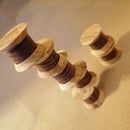Introduction: WITCO Inspired Artworks
I have a few favorite things. but the top two are making things and being with my friends.
So when one of my best friends asked me to help make some WITCO inspired artworks I thought it was a fantastic thing to do.
For the un initiated Witco started out as Western International Trading Company. They were really big in the 50'sand worked with some iconic mid century modern designs.
My buddy loves the "atomic art" look. He found reference materials to artworks similar to the ones he would like to make and we worked out some sizes.
Step 1: Measure and Cut
Martin measured out where the cuts should be made on plywood.
We cut these shapes out with a table saw and glued on some canvas material.
We used a spray adhesive.
Step 2: Drawing and Painting
With the canvas boards cut to shape martin freehand drew where his WITCO ish ducks should go and painted them in as well as his colored rectangles for the cat.
With these painted shapes in place we could work out how big the cat and the wings should be. We did this by overlaying tracing paper and sketching out the shapes we would later cut in wood refining the drawings until we were satiated.
Step 3: Flattening and Cutting Out
I used the plainer thicknesses to make sure the back side of the wooden peaces would be flat to the canvas before transferring the sketches of what would be needed in wood to the wood. (I used hemlock though any wood could be used.. the original artworks had a very distinctive gran pattern which was quite wide)
We cut the shapes out with a scroll saw.
Incidentally if you are using power tools it is much better to use safety equipment like guards and glasses (I know we didn't here but normally we do)
Step 4: Shapeing
We used a whole range of power tools and edge tools to make and refine the shapes.
The sanding station made shaping the wings very easy. A long neck grinder with a carving burr and a sanding disk worked fantastically on the cat and everything was refined further with hand tools followed by a mighty hand sanding.
When sanding start with a low grit and work upto a high one.. I have known people to spend a long time on a high grit .. It is a lot easier to take out the marks and then use progressive grits only to take away the scratches from the previous sandpaper.
We created a lot of dust.. When working with wood dust its a great idea to ware a respirator as the dust can cause serious health issues.
Step 5: Cut a Frame
I couldn't find framing molds to the shape I wanted for the artwork so used ash and cut it into an L shape. This allowed me to make a nice deep frame.
I cut miters in order to surround each of the artworks and then cut cross peaces for the cat artwork.
Step 6: Stain and Laqure
We thought the art would look great with a dark stain.
This is a mix of walnut and rosewood. I know a high end audio manufacturer once used a similar mix and called the result rosenut.
We stained all the peaces and gave them a few coats of finnish
Step 7: Assembly and a Quick Wax
With all the parts nice and dry we assembled. Glued everything together and clamped where needed with band clamps. The struts for the cat artwork were screwed into place and then martin used some nice neutral wax on the whole thing.
You can see that he loves the work.
Step 8: The Last Step Is to Enjoy
My friend now has an artwork that he can be super proud of.
They look fab in his home.

Participated in the
Bedroom Contest













